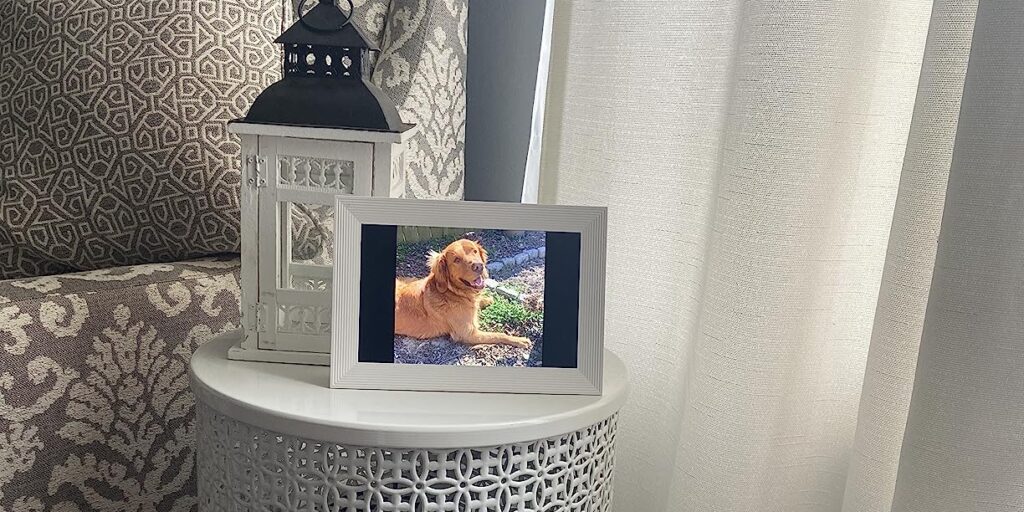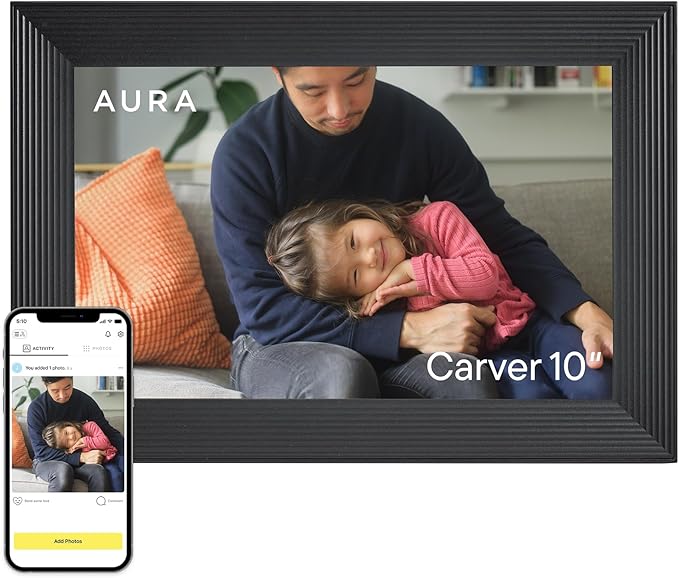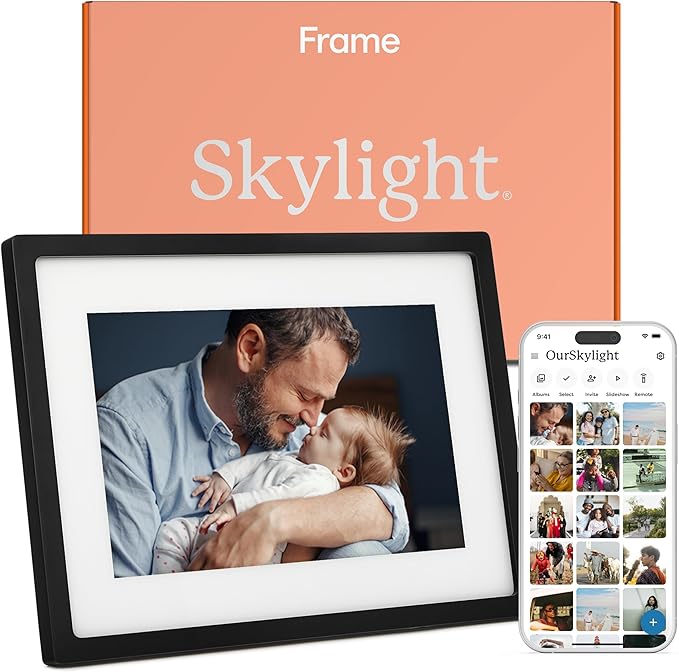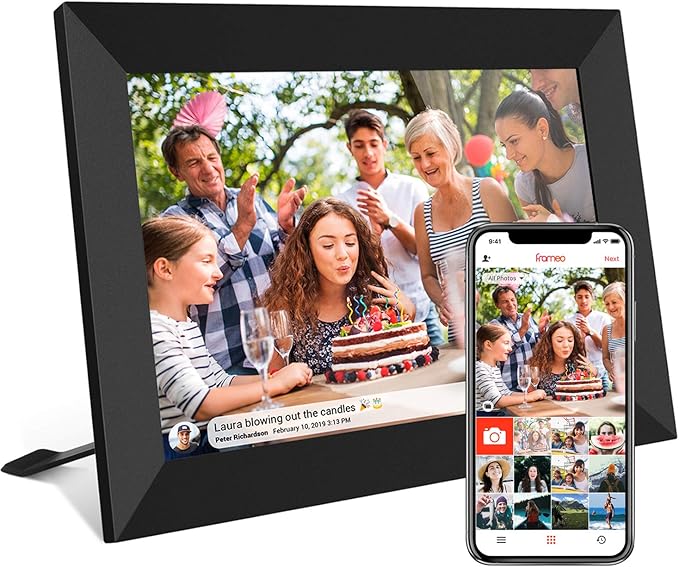Advertiser Disclosure
We independently review everything we recommend. When you buy through our links, we may earn a commission.
The Best Digital Photo Frames

We’ve all been there. You take hundreds of photos on your phone, maybe share a few on social media, and then they just… sit there. Trapped in the digital void of your camera roll, rarely seen again. It’s frustrating because those moments deserve better than to collect dust in a forgotten folder.
That’s exactly why our team spent three months testing digital photo frames to find the ones actually worth buying. We set up frames in living rooms, gifted them to parents who still think WiFi is complicated, and watched as thousands of photos cycled through various displays. Some frames impressed us immediately, while others looked great online but disappointed in real life.
After all that testing, we’ve narrowed it down to four standout options that solve different needs. Whether you’re looking for the perfect gift for tech-hesitant grandparents or want a premium frame that doubles as art, we’ve got you covered.
Everything We Recommend
✅ We recommend these products based on an intensive research process that’s designed to cut through the noise and find the top products in this space. Guided by experts, we spend hours looking into the factors that matter to bring you these selections.
⭐ 2.5 million+ people assisted in the last 30 days ⭐
🏆
The Best Overall
Aura WiFi digital frame is trusted by millions and featured by Wirecutter, Wired, and Oprah.
Setup takes minutes via WiFi with the free Aura app for iOS and Android devices.
Invite family to share unlimited photos and videos directly to your frame with free cloud storage.
HD color-calibrated display auto-adjusts brightness, cropping, and power for seamless photo viewing.
Perfect for gifting—preload photos, videos, and a custom message in its premium gift-ready box.
💎
The Best for Large Displays
Over 2 million users trust Aura’s 15″ WiFi frame, featured by Wirecutter, Wired, and Oprah.
Instantly send unlimited photos and videos from your phone to any Aura frame worldwide.
Setup takes under 5 minutes via WiFi using the free Aura app for iOS and Android.
15″ Full HD anti-glare screen auto-adjusts brightness, cropping, and includes a built-in speaker.
Use on tabletop or wall with included stand and mounting kit for flexible display options.
The Best Budget-Friendly WiFi Frame
Set up in minutes—plug in, connect WiFi, and share photos instantly via a unique Skylight email.
Send memorable photos as thoughtful gifts, perfect for birthdays, vacations, and everyday celebrations.
Stay connected across generations with shared digital albums that bring families closer every day.
Enjoy a vivid 10″ touch display with 1280×800 resolution and unlimited cloud-based photo storage.
Preload photos using Gift Mode or view offline—WiFi only needed for new uploads and sharing.
The cheapest
Share photos and 15-second videos securely via the Frameo app with 32GB storage and SD expansion.
Enjoy a 10.1″ IPS HD touchscreen with 1280×800 resolution for clear viewing from any angle.
Auto-rotate photos, display weather and clock, and customize brightness, sleep mode, and playback.
Easy setup with an intuitive touch interface—perfect for users of all ages in just minutes.
Display cherished memories for birthdays, weddings, or family gatherings right from your phone.
Why Traditional Photo Frames Can't Keep Up Anymore
Think about the last time you printed photos. For most of us, it’s been months or even years. Meanwhile, we’re capturing memories constantly on our phones. The math just doesn’t add up anymore.
Digital photo frames bridge that gap beautifully. They let you display hundreds or thousands of photos without lifting a finger after the initial setup. Even better, family members across the country can add photos directly to your frame, which means grandparents see pictures of the grandkids the same day they’re taken. That connection matters, especially when distance keeps families apart.
The technology has also improved dramatically. Early digital frames were clunky, with terrible displays and complicated setups that made people give up. Modern frames now feature crystal-clear HD screens, automatic brightness adjustment, and apps so simple that anyone can use them. We’re talking about frames that our team members’ 80-year-old relatives set up without help.
What We Actually Tested
Our testing process wasn’t just unboxing frames and looking at specs. We lived with these devices for weeks, treating them like regular household items because that’s exactly what they need to be.
We evaluated each frame on several critical factors. Display quality topped our list since there’s no point in a photo frame if the photos don’t look good. We tested in various lighting conditions, from bright sunny rooms to dimly lit bedrooms, checking how colors appeared and whether glare became an issue. The setup process mattered too because a frame that’s hard to configure often ends up in a closet. We handed frames to family members with varying tech skills and watched what confused them.
Battery life and power options came into play for portable frames. The WiFi connectivity strength was crucial since these frames depend on it. We also examined how easy it was to add photos, manage slideshows, and invite family members to contribute their own pictures. The app experience significantly impacts daily use, so we spent considerable time with each manufacturer’s software.
Finally, we considered value. A frame doesn’t need to be cheap, but it should deliver features that justify its price tag. Modern digital frames should offer at least 1280×800 resolution and intuitive cloud integration to meet current consumer expectations.
Top Digital Photo Frames Our Picks
After testing dozens of frames, the Aura Carver kept ending up back in our living room. There’s something special about a product that just works exactly as it should, and this 10.1-inch frame nails that experience from the moment you plug it in.
The display is where the Carver truly shines. With its 1280×800 HD resolution and color-calibrated screen, your photos look vibrant and true to life. We tested this frame side-by-side with others, and the color accuracy was noticeably better. Pictures taken on cloudy days didn’t look washed out, and sunset photos maintained their warm, golden tones. The frame’s automatic brightness adjustment is surprisingly intelligent, too. It adapts throughout the day without making dramatic shifts that catch your eye, which means the photos always look natural, whether it’s morning or midnight.
What really won us over was how effortlessly the Carver fits into daily life. You’re not constantly thinking about it or adjusting settings. The Aura app makes adding photos ridiculously simple. Snap a picture on your phone, and within seconds, you can send it to the frame. Better yet, you can invite unlimited family members to share photos, which means grandparents see their grandkids’ latest adventures without anyone needing to explain cloud storage or file sharing.
The setup process took us under five minutes, and we’re including the time it took to download the app. You plug in the frame, connect it to WiFi through the app, and you’re done. No complicated menu systems or confusing options. Our team member’s mother-in-law set hers up independently, which speaks volumes about the user-friendly design.
Storage is another area where Aura gets it right. You get unlimited free cloud storage with no subscription fees down the road. This matters because you’ll want to add photos continuously, and hitting storage limits kills that spontaneous sharing. The frame cycles through your photos intelligently, showing you a good variety without repetitive patterns.
The frame itself is beautifully designed with premium materials that look expensive. It’s not trying to be invisible; it’s an attractive piece that enhances your space. We tested it in multiple rooms, and it looked at home everywhere from modern apartments to traditional living rooms. The landscape orientation works perfectly for most photos, and the built-in speakers mean video clips play with sound, which adds another dimension to your memories.
This frame is perfect for anyone who wants the absolute simplest path from phone photos to a beautiful display. If you’re buying a gift for parents or grandparents, this is your answer. If you just want something that works flawlessly without fiddling, the Carver delivers exactly that. We found ourselves recommending it to friends and family repeatedly because we knew they’d love it.
When we first set up the Walden, the immediate reaction from everyone who walked into the room was “wow.” The 15-inch display commands attention in the best possible way, transforming your photos into genuine focal points rather than afterthoughts on a bookshelf.
The extra screen real estate changes how you experience photos. Group shots that feel cramped on smaller frames suddenly have space to breathe. Landscape photos of vacations or nature feel immersive instead of miniature. We tested this frame with everything from professional photography to quick phone snapshots, and the larger format elevated them all. The 1600 x 1200 resolution ensures that even on this bigger screen, images stay sharp and detailed.
What surprised us most about the Walden was how it made us rediscover photos we’d forgotten about. When a photo fills a 15-inch screen instead of a 7-inch one, you notice details you’d overlooked. Facial expressions become clearer, backgrounds tell more of the story, and the emotional impact increases significantly. One tester mentioned that a photo of her late father, which she’d seen dozens of times on her phone, made her tear up when it appeared on the Walden because she could finally see his expression clearly.
The Walden shares all the smart features that make Aura frames exceptional. The setup remains incredibly simple, the app is intuitive, and you get that same unlimited free cloud storage. The frame’s orientation flexibility is particularly useful at this size. You can display it in landscape or portrait, and the photos automatically adjust. We found the portrait orientation especially good for photos of people, while the landscape worked beautifully for travel shots.
The automatic brightness adjustment is crucial on a display this large. In a dark room, a bright 15-inch screen would be jarring, but the Walden adjusts smoothly to maintain comfortable viewing. The color calibration ensures consistency whether you’re looking at the frame from across the room or standing right next to it.
This frame works best for people who have a dedicated space where they want to make a statement. Think living room walls, home offices, or master bedrooms where the frame becomes a centerpiece. It’s also incredible for families who share lots of photos. The larger screen means everyone can enjoy the slideshow together from different spots in the room, making it a natural gathering point during family time.
We particularly recommend the Walden for photography enthusiasts or anyone who takes the visual presentation of their home seriously. If you’ve invested in good cameras or care about composition, this frame does justice to that effort. It’s also wonderful for aging family members who might struggle to see details on smaller screens. The size makes photos accessible without squinting or moving closer.
Not everyone wants to spend premium prices on a digital frame, and that’s exactly where the Skylight comes in. After testing this frame extensively, we were genuinely impressed by how much value it delivers at its price point.
The Skylight’s standout feature is its email-to-frame system, which is brilliantly simple. You get a dedicated email address for your frame, and anyone can send photos to it by email. That’s it. No apps to download for senders, no accounts to create, no complicated sharing permissions. Your aunt wants to share vacation photos? She emails them. Does your cousin have pictures from the family reunion? Email. This accessibility makes the Skylight perfect for families where not everyone is tech-savvy or wants another app on their phone.
We tested this feature with extended family members ranging from teenagers to great-grandparents, and everyone found it intuitive. The frame displays new photos within minutes of receiving the email, and you can even include a message that appears with the photo. These little notes add context and personality that make scrolling through photos more meaningful. One team member’s grandmother started sending daily photos with short updates about her day, creating an unexpected connection that went beyond just sharing images.
The touchscreen interface makes managing photos straightforward. You can easily favorite certain photos, delete ones you don’t want, or rearrange the slideshow order directly on the frame. This hands-on control is useful because not every photo someone sends needs to live forever in your rotation. The 10-inch touchscreen is responsive and doesn’t require precise tapping, which we appreciated during testing.
Setup is refreshingly simple. The frame walks you through the WiFi connection with on-screen instructions, and you’re up and running in about ten minutes. The display quality is solid for the price point, with good color reproduction and adequate brightness for most rooms. It’s not quite as vibrant as premium options, but photos still look good, and most people won’t notice the difference unless they’re comparing frames side by side.
The Skylight works best for budget-conscious buyers who still want legitimate WiFi functionality. It’s excellent for grandparents who receive photos from multiple family members since the email system requires zero technical knowledge from senders. We also found it perfect for vacation homes or rental properties where you want a nice touch without worrying about expensive equipment. The straightforward interface makes it accessible for anyone, regardless of their comfort level with technology.
One minor limitation we noticed is the lack of automatic cloud backup. Photos stay on the frame’s internal storage, so if you want to keep copies elsewhere, you’ll need to manage that separately. However, for most users who primarily want a display for current photos rather than archival storage, this isn’t a significant issue. Frames in this price range typically sacrifice some premium features but can still deliver excellent core functionality.
The Akimart frame caught our attention because it packs genuinely useful smart features without making things complicated. After spending weeks with it, we found it hits a sweet spot between functionality and usability that many frames miss.
The 32GB of internal storage is generous, especially at this price point. During testing, we loaded over 10,000 photos onto the frame and still had space left. This capacity matters because you’re not constantly managing storage or deleting photos to make room for new ones. The frame can hold your entire photo library, which means it can genuinely surprise you by showing photos you haven’t thought about in years.
What impressed us most was the frame’s versatility in how you add content. Yes, it has WiFi and works with the included app, but it also accepts USB drives and SD cards directly. This flexibility proved invaluable during testing. When WiFi was spotty, we simply transferred photos via USB. When a family member visited with photos on their camera’s SD card, we popped it into the frame and viewed them immediately. Many premium frames force you to use only their ecosystem, so this open approach feels refreshingly user-friendly.
The companion app is straightforward without unnecessary complications. You can send photos from your phone, schedule when the frame turns on and off, adjust slideshow settings, and create playlists of photos for different moods or occasions. We particularly liked the playlist feature. You can create a collection of holiday photos, another of vacation memories, and another of family portraits, then switch between them depending on the season or your mood.
The display quality genuinely surprised us for a frame at this price. The 1280×800 Full HD resolution means photos look sharp and detailed. Colors appeared accurate during our testing, though not quite as vivid as the premium Aura models. The viewing angles are good, so the photo quality doesn’t degrade when you’re looking at it from the side, which matters when the frame is positioned on a shelf or mantel where people view it from various angles.
Motion sensor technology helps save energy. The frame detects when someone is in the room and turns on automatically, then turns off when the room is empty. During testing, this feature worked reliably, though there was a slight delay of a few seconds. We found this helpful for frames placed in bedrooms or offices where you don’t need them running 24/7.
The frame design is clean and modern without trying too hard to be trendy. It doesn’t have the premium materials of higher-end options, but it looks perfectly fine in most settings. We tested it in home offices, bedrooms, and living spaces, and it fit in appropriately everywhere. The stand allows for both horizontal and vertical orientation, and the frame automatically adjusts photos to match.
This framework works beautifully for tech-comfortable users who want control and options. If you like having choices about how you add photos, organize them, and manage the device, the Akimart delivers that flexibility. It’s also excellent for anyone with an extensive photo collection who wants local storage rather than relying entirely on cloud services. We found it particularly appealing for people who travel frequently, since you can preload it with photos and it doesn’t depend on WiFi to function.
What to Look for When Buying a Digital Photo Frame
After testing numerous frames, we’ve identified the features that actually matter in real-world use versus those that just look good in product descriptions.
Display Quality: The Make-or-Break Factor
Your frame’s screen is everything. We’ve seen frames with impressive specs that looked terrible in person, and others with modest specifications that displayed photos beautifully. Resolution matters, but it’s not the only factor. Look for at least 1280×800 pixels for frames 10 inches or larger. Color accuracy and brightness range are equally important. The best frames calibrate their colors to represent photos accurately, not just cranking up saturation to make images “pop” artificially.
Anti-glare coatings make a significant difference in usability. During testing, we placed frames near windows and under lights to see how they handled reflections. Some screens became mirrors in bright light, while others remained viewable from any angle. If you’re planning to put your frame in a naturally lit space, prioritize models with quality anti-glare technology.
Viewing angles determine whether photos look good from different positions in a room. Some cheaper frames only look decent when you’re standing directly in front of them. Premium models maintain color and contrast even when viewed from the side. This matters more than you’d think, especially for frames placed on shelves or tables where people naturally view them from various angles.
Connectivity: Cloud or Local Storage
The storage approach affects how you’ll use your frame daily. Cloud-connected frames like the Aura models offer unlimited storage and automatic synchronization across devices. You take a photo, send it to the frame, and it appears within seconds. The downside is that you need reliable WiFi, and if the company’s servers go down, your frame stops receiving updates.
Local storage frames store photos directly on internal memory or SD cards. They work without internet once loaded and give you complete control over your content. However, adding new photos requires physical access to the frame or its memory card. Some frames, like the Akimart, cleverly offer both options, giving you flexibility based on your situation.
The WiFi connectivity has become the preferred standard among consumers, with 78% of digital frame buyers prioritizing wireless capability in 2024.
User Experience: Setup and Daily Operation
The best frame is useless if it’s too complicated to set up or frustrating to use daily. We evaluated setup processes across all our test models, and the differences were stark. The simplest frames had us displaying photos in under five minutes. The most complicated ones required account creation, firmware updates, and troubleshooting that consumed over an hour.
Look for frames with straightforward apps and clear instructions. The interface should make common tasks obvious. Adding photos, inviting family members to share, and adjusting basic settings like brightness shouldn’t require digging through menus or reading manuals. During testing, we found that if we had to consult documentation for basic operations, most users would struggle with those features too.
Consider who will be using the frame. If you’re gifting it to someone less tech-savvy, prioritize simplicity over advanced features. We’ve seen too many well-intentioned gifts end up unused because they were too complicated for the recipient to set up or manage.
Smart Features That Actually Matter
Motion sensors save energy by turning the frame off when nobody’s around. This feature worked reliably on most frames we tested, though some had noticeable delays. Auto-brightness adjustment adapts to room lighting, ensuring photos look good throughout the day without manual intervention. This became essential in our testing, especially for frames in rooms with varying natural light.
Automatic photo rotation ensures you’re not seeing the same images repeatedly. Better frames use intelligent algorithms to show you a good variety, occasionally surfacing older photos you’d forgotten about. Less sophisticated models just shuffle randomly, which can mean seeing the same photo multiple times, while others rarely appear.
Video playback with sound adds another dimension to memories. Not all frames support video, and those that do vary in quality. During testing, we found that frames with built-in speakers provided a much better experience than those relying on weak audio or requiring external speakers.
Setting Up Your Digital Photo Frame: What to Expect
The setup process varies by model, but we can walk you through what to expect based on our testing experience.
Most modern frames follow a similar pattern. You plug in the frame, and it powers on automatically, displaying setup instructions on the screen. You’ll download the manufacturer’s app on your smartphone and follow the prompts to connect the frame to your WiFi network. This usually involves selecting your network from a list and entering your password. The frame confirms the connection, and you’re ready to start adding photos.
The app guides you through adding your first photos. Some apps let you select multiple photos at once, while others require selecting them individually. You can usually choose photos from your phone’s camera roll, cloud services like Google Photos or iCloud, or social media accounts.
Once photos are loaded, you’ll adjust basic settings like transition speed, display duration per photo, and brightness. Most frames remember these preferences, so you’re not constantly readjusting. Many apps also let you invite family members to contribute photos by sending them an invitation link or code.
The entire process typically takes 10 to 30 minutes for first-time setup, depending on how many photos you’re adding initially. Subsequent photo additions take just seconds.
Maximizing Your Digital Photo Frame Experience
After extensive testing, we’ve learned several tricks that dramatically improve the digital frame experience.
Regularly refresh your photo collection. Even with thousands of photos loaded, the frame eventually starts feeling repetitive if you never update the selection. We recommend adding new photos monthly, even if they’re just recent snapshots. Those fresh images keep the frame feeling current and engaging rather than becoming wallpaper you stop noticing.
Create seasonal rotations. Several testers mentioned they enjoy adjusting photo collections to match the time of year. Summer vacation photos during warm months, holiday memories in December, and autumn shots in the fall all help the frame feel contextually relevant rather than static.
Invite extended family to contribute. The frames that generated the most engagement in our testing were those with multiple contributors. When grandchildren send photos to grandma’s frame, or siblings share pictures across the country, the frame becomes more than just a display. It becomes a connection point that strengthens relationships and keeps distant family members present in daily life.
Position matters more than you might think. We tested frames in various locations throughout homes and found that placement significantly impacts how often people actually look at them. High-traffic areas like kitchens, living rooms, or main hallways ensure the frame gets noticed. Frames placed in quiet bedrooms or offices might be enjoyed by one person, but don’t become shared family experiences.
Adjust brightness based on the room. Even frames with automatic brightness adjustment sometimes benefit from manual tweaking. A frame that looks perfect during the day might be too bright for a bedroom at night. Most apps let you set schedules for different brightness levels, which we found helpful during extended testing.
Common Questions About Digital Photo Frames
Do digital photo frames require subscriptions?
This varies significantly by brand. Aura frames include unlimited free cloud storage with no subscription fees, which is part of what makes them such strong values. Some budget brands charge monthly fees for cloud storage or premium features. Always check before buying because those ongoing costs can exceed the frame’s initial price over time. During our testing, we specifically prioritized frames without hidden subscription requirements because we know how frustrating those surprise costs can be.
Can I display videos on these frames?
Many modern frames support short video clips in addition to photos. The Aura Carver plays videos with built-in speakers, which adds wonderful moments to your slideshow. However, implementation varies wildly. Some frames limit video length to 15 seconds, while others accept longer clips. Quality differs, too. We found that frames with dedicated video compression tend to play clips more smoothly than those treating videos as extended photos.
How much WiFi data do these frames use?
Very little, surprisingly. During testing, we monitored network usage across several frames over a month of regular use. Most consume less than 500MB monthly, primarily from initial photo uploads. Once photos are stored on the frame or in the cloud, data usage drops to minimal maintenance updates. You won’t notice any impact on your overall bandwidth, even if you’re adding photos daily. The frames connect using standard 2.4GHz WiFi, which works with virtually all home routers.
Can I use these frames without WiFi?
Some models, yes, others no. Cloud-dependent frames like the Aura models require WiFi to receive new photos, though they’ll continue displaying already-loaded photos if the connection drops. Frames with SD card or USB support, like the Akimart, function completely offline once loaded with photos. If reliable internet isn’t available where you plan to use the frame, prioritize models with local storage options.
How long do digital photo frames last?
Based on manufacturer specifications and user reports, quality digital frames typically last 5-7 years with regular use. The LCDs are generally the longest-lasting component, often rated for 50,000 hours or more. During testing, we examined frames that users had owned for several years, and most showed minimal degradation in display quality. Electronics can fail earlier if overheated or damaged, so proper placement away from heat sources extends lifespan.
Making the Right Choice for Your Needs
Selecting the perfect digital photo frame comes down to matching features with your specific situation. Let us break down which frame serves different needs best based on our testing experience.
If you want the absolute best experience without worrying about budget, the Aura Carver delivers exceptional quality, effortless setup, and beautiful display quality. It’s the frame we’d buy for ourselves, and it’s what team members have purchased for their own families. The investment pays off in daily enjoyment and longevity. The Aura Walden extends these benefits to a larger format that transforms photos into genuine focal points.
Budget-conscious shoppers who still want WiFi capability should look hard at the Skylight. It delivers the essential connected experience without premium pricing, and the email-to-frame feature is genuinely innovative in its simplicity. While it doesn’t match premium frames in display quality or build materials, it absolutely succeeds at the core mission of displaying photos beautifully and making sharing effortless.
Tech enthusiasts and anyone with extensive photo libraries will appreciate Akimart’s versatility. The combination of WiFi connectivity, generous internal storage, and physical media support provides flexibility that appeals to people who want options. It’s the frame we’d recommend for anyone who shoots with dedicated cameras or wants local storage control.
Gifting a frame? Consider your recipient carefully. Tech-comfortable people will appreciate the features and capabilities of the Aura Carver. For relatives who find technology intimidating, the Skylight’s email simplicity removes barriers that might otherwise prevent them from enjoying the device. We’ve seen both approaches succeed during testing, and matching the frame to the person matters more than simply buying the most expensive option.
The Bottom Line: Bringing Your Memories to Life
After months of testing, living with these frames, and watching family members interact with them, we’ve concluded that digital photo frames have finally reached their potential. Early models were clunky novelties, but today’s frames are genuine solutions to a real problem: how to enjoy the thousands of photos we capture without spending hours printing and framing.
The frames we’ve recommended here all passed our rigorous testing and proved themselves in real-world daily use. The Aura Carver remains our top overall pick because it excels at everything that matters. Beautiful display, simple operation, unlimited storage, and build quality that justifies the investment. The Walden takes these strengths and amplifies them through a larger format that makes photos impossible to ignore.
The Skylight proves you don’t need a premium budget to bring your photos to life, while the Akimart delivers flexibility and features that appeal to control-focused users. Each frame serves its intended audience well, and choosing between them is more about matching capabilities to needs than identifying a single universal winner.
What struck us most during testing wasn’t the technology itself, but the emotional impact these frames created. Watching grandparents light up when photos of grandchildren appeared. Seeing families gather around frames during holidays, reminiscing about captured moments. Observing how these devices sparked conversations and strengthened connections across distances. That’s what makes digital photo frames worthwhile—not their technical specifications, but their ability to keep our most precious memories visible and present in daily life.
Your photos deserve better than being trapped on your phone. These frames offer an elegant solution that requires minimal effort after setup and delivers daily joy. We’re confident that whichever option you choose from our recommendations, you’ll wonder why you waited so long to bring your memories to life.




